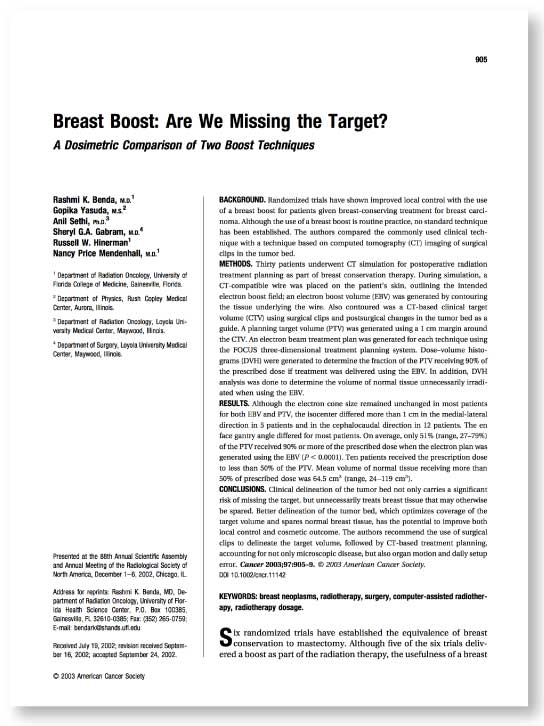Breast Boost: Are We Missing the Target?
A Dosimetric Comparison of Two Boost Techniques
Rashmi K. Benda, M.D.1, Gopika Yasuda, M.S.2, Anil Sethi, Ph.D.3, Sheryl G.A. Gabram, M.D.4, Russell W. Hinerman1, Nancy Price Mendenhall, M.D1
1Department of Radiation Oncology, University of Florida College of Medicine, Gainesville, Florida.
2Department of Physics, Rush Copley Medical Center, Aurora, Illinois.
3Department of Radiation Oncology, Loyola University Medical Center, Maywood, Illinois.
4Department of Surgery, Loyola University Medical Center, Maywood, Illinois.
BACKGROUND.
Randomized trials have shown improved local control with the useof a breast boost for patients given breast-conserving treatment for breast carcinoma. Although the use of a breast boost is routine practice, no standard technique has been established. The authors compared the commonly used clinical technique with a technique based on computed tomography (CT) imaging of surgical clips in the tumor bed.
METHODS.
Thirty patients underwent CT simulation for postoperative radiation treatment planning as part of breast conservation therapy. During simulation, a CT-compatible wire was placed on the patient’s skin, outlining the intended electron boost field; an electron boost volume (EBV) was generated by contouring the tissue underlying the wire. Also contoured was a CT-based clinical target volume (CTV) using surgical clips and postsurgical changes in the tumor bed as a guide. A planning target volume (PTV) was generated using a 1 cmmargin around the CTV. An electron beam treatment plan was generated for each technique using the FOCUS three-dimensional treatment planning system. Dose–volume histograms (DVH) were generated to determine the fraction of the PTV receiving 90% of the prescribed dose if treatment was delivered using the EBV. In addition, DVH analysis was done to determine the volume of normal tissue unnecessarily irradiated when using the EBV.
RESULTS.
Although the electron cone size remained unchanged in most patients for both EBV and PTV, the isocenter differed more than 1 cm in the medial-lateral direction in 5 patients and in the cephalocaudal direction in 12 patients. The en face gantry angle differed for most patients. On average, only 51% (range, 27–79%) of the PTV received 90% or more of the prescribed dose when the electron plan was generated using the EBV (P 0.0001). Ten patients received the prescription dose to less than 50% of the PTV. Mean volume of normal tissue receiving more than 50% of prescribed dose was 64.5 cm3(range, 24–119 cm3).

CONCLUSIONS.
Clinical delineation of the tumor bed not only carries a significant risk of missing the target, but unnecessarily treats breast tissue that may otherwise be spared. Better delineation of the tumor bed, which optimizes coverage of the target volume and spares normal breast tissue, has the potential to improve both local control and cosmetic outcome. The authors recommend the use of surgical clips to delineate the target volume, followed by CT-based treatment planning, accounting for not only microscopic disease, but also organ motion and daily setup error. Cancer 2003;97:905–9. © 2003 American Cancer Society.
DOI 10.1002/cncr.11142